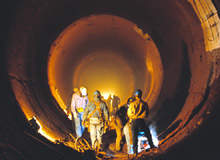
BHP Billiton’s Cerro Matoso nickel operation is situated in Columbia and combines a lateritic nickel ore deposit with a low-cost ferronickel smelter. It is the world’s second-largest producer of ferronickel and boasts some of the lowest costs. Mining commenced in 1980 and nickel production started in 1982 under the Colombian Government, BHP Billiton and Hanna Mining ownership.
BHP raised its ownership to 53% in 1989, to 98.8% in 1997, ten years later increasing its stake to the current 99.94%. Mine employees share 0.06% of the mine.
In 1999, an expansion project to double installed capacity was started, and in January 2001 the first metal was tapped from this second line. The smelter produces high-purity, low-carbon ferronickel granules. Production in FY2008 was 41,800t of contained nickel, some 9,000t lower than FY2007’s production principally due to an industrial stoppage during FY2008.
Higher electricity and gas costs also affected the overall performance of Cerro Matoso for 2008.
Cerro Matoso has an estimated reserve life of 42 years, based on current production levels, however BHP has identified opportunities to expand this significantly, notably building a third and fourth processing line and a heap leaching operation.
Pending board approval, BHP envisages that these projects could see capacity more than doubling over the next ten years.
The existing mining concession rights are renewable in 2012 with a 30-year extension period until 2042. Further extension is possible at that time.
The land on which the reserves are located is owned.
Geology and reserves
The deposit is developed over a peridotitic protolith that is exposed in the form of an elongated hill. The deposit’s weathering profile is variable both vertically and laterally, and ten distinct lithostratigraphic units have been characterised.
Two typical sections through the weathering profile were sampled from an area of the mine with high (pit 1) and lower (pit 2) Ni grades. Bench mapping has shown that pits 1 and 2 have distinctly different weathering profiles. From bottom to top, the profile in pit 1 is weakly serpentinized peridotitic protolith, saprolitized peridotite, green saprolite (main ore horizon), “tachylite” (used by mine geologists to describe an enigmatic Fe oxide horizon), black saprolite, yellow laterite, red laterite.
The sequence is then capped by a magnetic to nonmagnetic ferricrete known locally as “canga.” The succession in pit 2 is from serpentinized peridotite, saprolitized peridotite, brown saprolite, yellow laterite, red laterite and lacks the green saprolite ore horizon. All the units in pit 2 have currently uneconomic Ni grades.
The thickness of the units is highly variable, but most of the major horizons have maximum thicknesses of the order of tens of meters. Both pits contain abundant fault- and joint-related silicate veins, sometimes in stockworks, in the lower part of the sequence. These veins contain the distinctive green mineral known as “garnierite” (actually pimelite, a form of nickeliferous talc) as well as quartz and chalcedony, and they can have a Ni content of up to 30% to 40%
Ferronickel production
BHP’s 2008 annual report states proven ore reserves as under 25mt, with probable reserves between 25mt and 70mt.
The ore reserve has increased as a result of revised price forecasts, reducing the Laterite ore cut-off grade used in the reserve estimation from 1.0%Ni to 0.6%Ni. In addition, revised metallurgical recovery parameters have also resulted in an increase to the reserve.
The ore mined from the open pits is sent to Cerro Matoso’s smelter for processing. High-purity and low-carbon ferronickel granules are produced by the smelter. These ferronickel granules are used exclusively in stainless steel production.
The second line of production commenced in January 2001. This expanded the smelter’s production capacity to 50 000t per year, making Cerro Matoso one of the largest ferronickel producers in the world.
Conceptual studies were undertaken for expanding production at Cerro Matoso. This includes building a third and fourth processing line and a heap leaching operation. All these measures aim at doubling Cerro Matoso’s capacity within ten years.
Existing ore reserves
The Cerro Matoso mine has the highest-grade lateritic nickel deposits in the world. With exploration rights over 77,000ha in the main part of the Colombian nickel belt, Cerro Matoso has mining concessions containing reserves capable of sustaining the current level of production for at least 20 years.
Mining and processing
The ferronickel smelter and refinery are integrated with the mine. Beneficiation plant for the mine consists of a primary and secondary crusher, which is sent to a stacker for ore stockpiling and blending. Process design capacity is 50,000t per annum. Actual capacity depends on nickel grade from the mine.
Electricity is supplied from the national grid based on supply contracts negotiated for five-year periods. The existing electricity supply contract terminates in December 2010.
A pipeline supplies domestic natural gas for drier and kiln operation.
Production
Production in FY2008 was 41,800t of contained nickel, some 9,000t lower than FY2007’s production principally due to an industrial stoppage during FY2008.
Costs were higher due to increased electricity and gas costs. The mine has an estimated reserve life of 42 years, based on current production levels, however BHP has identified opportunities to expand this significantly, notably building a third and fourth processing line and a heap leaching operation. Pending board approval, BHP envisages that these projects could see capacity more than doubling over the next ten years.

